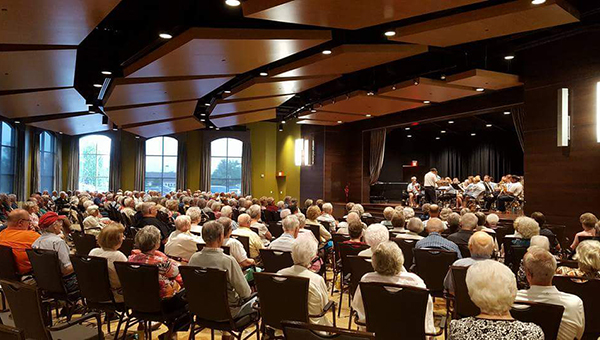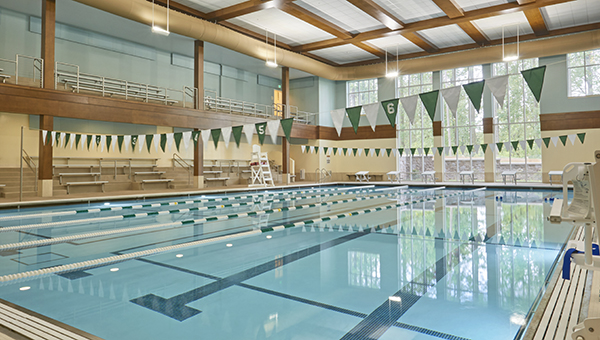Posts
Supporting Student Wellness and Campus Health through Design
May 11, 2022 For many young adults, college is the first time they’ve been on their own and away from their support network of family and close friends. COVID-19 made this time of sudden change even more stressful for many by limiting social interactions and activities while still expecting students to keep up with their courses. This dramatic and sudden change has highlighted the importance of student wellness design.
For many young adults, college is the first time they’ve been on their own and away from their support network of family and close friends. COVID-19 made this time of sudden change even more stressful for many by limiting social interactions and activities while still expecting students to keep up with their courses. This dramatic and sudden change has highlighted the importance of student wellness design.
College campuses nationwide have reported higher levels of depression, anxiety, and stress. According to a survey by the American Council on Education, 72% of college and university presidents identified student mental health as a pressing issue for the 2021-22 school year. Mental health challenges can also result in less physical activity, eating too much or too little, making unhealthy food choices and sleep disruptions. As a consequence of the psychological stress, both physical well-being and academics can suffer.
SUSTAINABLE DESIGN 2021: Taking a Look at the WELL Health-Safety Seal
June 10, 2021 In the wake of a 13% drop in enrollment for 2020-2021, colleges and universities are considering new strategies to attract students. Priorities have shifted for students and staff as we emerge from the COVID-19 pandemic. Sustainable design standards have likewise adapted with offerings such as the WELL Health-Safety Seal to help foster trust and encourage a return to pre-pandemic campus life.
In the wake of a 13% drop in enrollment for 2020-2021, colleges and universities are considering new strategies to attract students. Priorities have shifted for students and staff as we emerge from the COVID-19 pandemic. Sustainable design standards have likewise adapted with offerings such as the WELL Health-Safety Seal to help foster trust and encourage a return to pre-pandemic campus life.
The International WELL Building Institute is just one of several organizations to develop specialized standards to address the renewed focus on infection control and safely reopening indoor environments. The U.S. Green Building Council (USGBC), the Center for Active Design, and RESET have each developed modules to help facility managers measure, improve and monitor air quality, sustainability, and/or health and wellness strategies.
INTERIOR DESIGN FOR WELLNESS: Strategies to Encourage Physical Activity in Older Adults
March 31, 2021 Interior design for wellness spaces allows our team to encourage physical activity, especially for the older adults living in the senior living communities we serve. The benefits of physical activity are well documented, along with the fact that most people need more of it. This is especially true for older adults. A multi-year study by Mather Lifeways Institute on Aging has documented that people living in life plan communities report more healthy behaviors than other older adults, in part due to the ready availability of resources. In recent years, we have seen a number of life plan communities place renewed emphasis on resident health and well-being by expanding or updating their wellness facilities.
Interior design for wellness spaces allows our team to encourage physical activity, especially for the older adults living in the senior living communities we serve. The benefits of physical activity are well documented, along with the fact that most people need more of it. This is especially true for older adults. A multi-year study by Mather Lifeways Institute on Aging has documented that people living in life plan communities report more healthy behaviors than other older adults, in part due to the ready availability of resources. In recent years, we have seen a number of life plan communities place renewed emphasis on resident health and well-being by expanding or updating their wellness facilities.
Community Outreach for Wellness
December 19, 2019 Senior wellness is defined by more than just physical health. As humans, we are social by nature, seeking ongoing opportunities to remain connected to people and places around us. Wellness programming that engages both the physical and mental elements of older adults’ well-being presents creative opportunities for today’s senior living communities.
Senior wellness is defined by more than just physical health. As humans, we are social by nature, seeking ongoing opportunities to remain connected to people and places around us. Wellness programming that engages both the physical and mental elements of older adults’ well-being presents creative opportunities for today’s senior living communities.
Seniors may experience loneliness due to the loss of a spouse or partner, or distance from family and friends. While senior living wellness programs offer ample opportunities for social and emotional engagement, older adults can also benefit from opportunities that transcend community boundaries.

Wellness programming that exposes residents to external community connections can prevent isolation and loneliness and give older adults a sense of purpose. Community partnerships that provide opportunities for intergenerational interaction through the community’s own facilities, educational outreach, or other public programs not only expand social connections, but also engage residents’ unending desire to learn.
As a result, senior living communities are creating wellness programs that facilitate resident experiences both on and off campus, and also allow non-residents to enjoy programs available within a senior living community.
Performance centers integrated within a campus or community center can help residents fulfill a need for intellectual and social stimulation. Art exhibitions, concerts, staged productions, and other events that are opened to the public elevate the community’s value for all guests. This is a powerful marketing tool, demonstrating a vibrant and active community lifestyle for non-residents to see.

Pools and natatoriums are often considered basic physical wellness components, but don’t need to be limited exclusively to resident use. Like a performing arts center, opening a pool or natatorium to the greater community can build strong public partnerships with local groups and educational institutions. Allowing swim teams or not-for-profit groups to use the facility for competition or educational programs creates intergenerational opportunities for residents and community members alike. Resident volunteers can participate as hospitality hosts, timing officials, swim meet marshals or in other capacities. A campus may also allow employees and community members to register for pool memberships that permit access to the facility during set hours.
Intellectual curiosity and educational exploration are common themes, as most senior living residents maintain their love of learning well into older age. Lifelong learning opportunities on and off campus are an increasingly popular program offering among seniors. Pursuing educational or informational courses can help older adults refresh early life experiences, learn new skills, and understand distant cultures while interacting with others who share common interests.
The key to life-long well-being lies in both physical and cognitive exercise. Senior living wellness programs need not be limited to campus residents alone. Operators who can open wellness programming to staff, not-for-profit groups, and others from the greater community create a win-win for campus residents and the general public alike.
For more about how wellness is evolving in the senior living arena, read our latest case study, Wellness in Independent Living, available through the Wellness resource page.
To learn how Wellness might fit your development needs, Contact Us today for more information.
Outdoor Programming for Wellness
 Wellness among older adults has traditionally been considered a physical goal of health and mobility, often achieved in a gym, pool, or fitness center. But senior living community operators are now tapping into the natural environment for resident wellness outdoor programming opportunities as well.
Wellness among older adults has traditionally been considered a physical goal of health and mobility, often achieved in a gym, pool, or fitness center. But senior living community operators are now tapping into the natural environment for resident wellness outdoor programming opportunities as well.

Today’s senior living population is more active into older age, and often engage in some type of physical activity as part of their lifestyle. A significant portion of seniors cite wellness programs as a deciding factor in choosing a senior living community, suggesting that wellness is increasingly important to both current and future residents.
In response to changing expectations, senior living communities are looking outdoors to enhance their resident wellness programming. Including exterior spaces such as walking trails, community gardens, exercise areas, and fitness stations not only serves to enhance residents’ physical health, but other areas of wellness as well.
Outdoor wellness programming in senior living environments has been proven to positively impact all areas of resident wellness. In this context, the term wellness takes into account the whole person, incorporating not just physical health, but also residents’ emotional, spiritual, intellectual, occupational, social, and environmental well-being.
Open-air senior living environments now serve multiple purposes. A beautifully-landscaped community courtyard may double as a meditation garden or exercise area for yoga, tai chi, and other fitness classes. While focused on physical exercise, these activities also encourage social interaction and serve to enhance residents’ emotional, spiritual, and environmental wellness. Flower gardens maintained by community residents can be used for social and emotional wellness, or to visually enhance interior spaces by bringing nature indoors.
Recreation areas for lawn games such as bocce ball and croquet, or shuffleboard and pickle ball courts, target residents’ physical health, yet also enhance their social, occupational, and environmental wellness. Intentionally designed exterior spaces, like walking trails with fitness stations, offer less strenuous activity than lawn games but create equally impactful environmental and social experiences.

Outdoor cooking and dining present additional opportunities for senior living wellness programming. Open-air cooking classes and demonstrations, fully-equipped outside kitchens, and al fresco dining venues are increasingly popular among senior living communities for their social, intellectual, environmental, and occupational values. Produce made available through community herb or vegetable gardens and greenhouses can be used to create a farm-to-table experience and promote healthy eating.
Meeting seniors’ wellness needs transcends physical exercise and therapy activities. Today’s residents want greater opportunities to maintain and enhance their wellness as part of a healthy lifestyle. Senior living communities are looking to the natural environment to improve residents’ lives across the spectrum of wellness, helping to provide spaces to socialize and enjoy individual and group activities that stimulate the mind as well as the body.
For more about how wellness is evolving in the senior living arena, read our latest case study, Wellness in Independent Living, available through the Wellness resource page.
To learn how Wellness might fit your development needs, Contact Us today for more information.
WORKING WELL: The WELL Building Standard and Contemporary Office Design
August 23, 2018 Physical workspace is an important, often overlooked, component of employee satisfaction – not only for recruitment of new employees, but also for maintaining your existing workforce. The evolution of the WELL Building Standard reflects growing awareness and interest in creating healthy workspaces that promote employee engagement, productivity, health and well-being. Launched in 2014 by a former Wall Street veteran, Paul Scalia, WELL originated to promote a healthier version of the modern office.
Physical workspace is an important, often overlooked, component of employee satisfaction – not only for recruitment of new employees, but also for maintaining your existing workforce. The evolution of the WELL Building Standard reflects growing awareness and interest in creating healthy workspaces that promote employee engagement, productivity, health and well-being. Launched in 2014 by a former Wall Street veteran, Paul Scalia, WELL originated to promote a healthier version of the modern office.